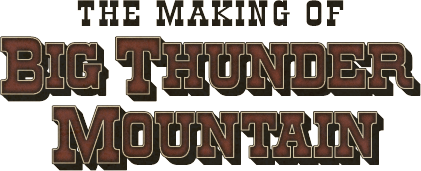
Nº 6 — Le Far West
When creating the grotto scene for the trains’ arrival on the island, the Imagineers wanted it to have a distinct look from the rest of the ride. “It was to be all natural with no mine timbering or related track and cars. We did a little expedition scene with exploration-type props as you would see in the adaption of Jules Verne's Journey to the Center of the Earth with James Mason. That was our model, as well as the old Rainbow Caverns at Disneyland,” Pat Burke recalls.
The other two lift hills (and much of the rest of the ride) were filled with mining artifacts and show elements to tell the story of the fictional Big Thunder Mining Co. and its place in Frontierland… all the while providing (fabricated) dangers and humorous details to guests speeding past the intricate decoration. On the second lift, a new show scene introduced the voice of an old prospector in his bathtub who finds his clothes being nibbled on by a goat.

The mountain itself, still based on the buttes of Monument Valley, was made even bigger and more realistic. “We added over one hundred feet to the main butte as compared to Tokyo Disneyland's to make it more majestic and challenge the castle height as the tallest point in the park. Fantasyland designer Tom Morris was worried the day we set the main butte as they were setting the top turret on the castle.” The castle, it turned out, was slightly taller. “We could have won but did not want to break the golden rule of the castle being the tallest.”
When a concept that was meant to fill the space across from the attraction was cancelled, two items originally intended for the ride’s queue area were moved to take its place. Rose’s Blacksmith shop, which was designed for a space between the re-entry track and the load building, and the Minneapolis traction engine, which was going to fill the corner now taken by the Big Thunder Photographer building, would cross the street and set up camp next to the Fuente del Oro restaurant. “Tony Baxter liked that better in the end,” adds Pat.

The blacksmith shop across the road.
Some design decisions were dictated by technical considerations such as underground pipeline corridors, and had to be adapted over the course of the ride’s creation. Pat Burke explains, “Originally we had a much bigger pond in front of Big Thunder Mountain, but the park’s central corridor kept changing and cutting into our front pond, making it smaller. Even after we started building the park and BTM, the big pipe kept moving towards the load building and we had to make in-field changes.” Despite this pipeline “moving around like a snake in an underground burrow in front of Big Thunder,” the project was steadily taking shape.
Graphic designer Leticia Lelevier created signage and various themed graphics, for which Pat Burke would often provide appropriate wordings. The BTM (or TWB) logo designed for the original attraction in Disneyland was used extensively to further anchor the environment in the story. Pat also designed custom exit signs to resemble period kerosene lanterns (an effort he would reprise years later in a nautical theme when working on the SS Columbia for Tokyo DisneySea).

Concept for the “kerosene” exit signs. © Disney.
The small assay office in the queue line, filled with a maximum of delicate authentic objects, was determined to be the workspace of one Jack O'Ferges, or "Big Jack," the mine's foreman, as themed signage informs us. This was an in-joke reference to Jack Ferges, a long-time model maker at Imagineering. Pat relates: “Maybe 6′5″ high he could build the smallest, most detailed model pieces.” What was more, “Big Jack had the smallest office space at WDI, much like the foreman's office upstairs.”

Two references to Jack Ferges.
New sound effects were recorded for the attraction, some utilizing the very machinery that Pat Burke had collected as props. The high-pitched train whistle of previous versions was replaced by a deeper, more haunting sound. Sounds of miners toiling away in the depths of their shafts were added to various set pieces and new dialogue was recorded for the old miner in his cabin.
Among the audio tracks reused from the ride’s original incarnation were the English-language safety spiels recorded by legendary voice actor Dal MacKennon. Only the unload safety spiel — not used in previous attractions — had to be newly recorded. When Jeff Burke heard the announcements which Imagineer Eddie Sotto had recorded for the Euro Disneyland Railroad, he asked the Main Street lead designer to try out a Dal MacKennon-style voice for the new Big Thunder spiel. As a side note, changes to the other parks’ audio over the years have now made Disneyland Paris the only park to still play MacKennon’s original safety spiels.

| 
